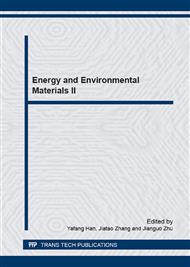[1]
M. Armand, J.M. Tarascon, Building better batteries, Nature 451 (2008) 652-657.
DOI: 10.1038/451652a
Google Scholar
[2]
T.H. Kim, J.S. Park, S.K. Chang, S. Choi, J.H. Ryu, H.K. Song, The current move of lithium ion batteries towards the next phase, Adv. Energy Mater. 2 (2012) 860-872.
DOI: 10.1002/aenm.201200028
Google Scholar
[3]
J.B. Goodenough, Y. Kim, Challenges for rechargeable Li batteries, Chem. Mater. 22 (2010) 587-603.
Google Scholar
[4]
M.J. Armstrong, C. O'Dwyer, W.J. Macklin, J.D. Holmes, Evaluating the performace of nanostructured materials as lithium-ion battery electrodes, Nano Research 7 (2014) 1-62.
DOI: 10.1007/s12274-013-0375-x
Google Scholar
[5]
T. Ohzuku, Y. Makimura, Layered Lithium Insertion Material of LiCo1/3Ni1/3Mn1/3O2 for Lithium-Ion Batteries, Chem. Lett. 30 (2001) 642-643.
DOI: 10.1149/ma2005-02/4/107
Google Scholar
[6]
W.H. Ryu, S.J. Lim, W.K. Kim, H. Kwon, 3-D dumbbell-like LiNi1/3Co1/3Mn1/3O2 cathode materials assembled with nano-building blocks for lithium-ion batteries, J. Power Sources 257 (2014) 186-191.
DOI: 10.1016/j.jpowsour.2014.02.003
Google Scholar
[7]
W. Xiong, Y. Jiang, Z. Yang, D. Li, Y. Huang, High-performance hierarchical LiNi1/3Mn1/3Co1/3O2 microspheres synthesized via a facile template-sacrificial route, J. Alloys Comp. 589 (2014) 615-621.
DOI: 10.1016/j.jallcom.2013.12.047
Google Scholar
[8]
X.F. Bie, F. Du, Y.H. Wang, K. Zhu, H. Ehrenberg, K. Nikolowski, C.Z. Wang, G. Chen, Y. J Wei, Relationships between the crystal/interfacial properties and electrochemical performance of LiNi0. 33Co0. 33Mn0. 33O2 in the voltage window of 2. 5–4. 6 V, Electrochim. Acta 97 (2013).
DOI: 10.1016/j.electacta.2013.02.131
Google Scholar
[9]
C.H. Lu, B.J. Shen, Electrochemical characteristics of LiNi1/3Co1/3Mn1/3O2 powders prepared from microwave-hydrothermally derived precursors, J. Alloys Comp. 497 (2010) 159-165.
DOI: 10.1016/j.jallcom.2010.02.127
Google Scholar
[10]
X.Y. Zhang, W.J. Jiang, X.P. Zhu, A. Maugera, Qilu, C.M. Juliend, Aging of LiNi1/3Co1/3Mn1/3O2 cathode material upon exposure to H2O, J. Power Sources 196 (2011) 5102-5105.
DOI: 10.1016/j.jpowsour.2011.02.009
Google Scholar
[11]
Y.Y. Zhang, X.Y. Wu, Y. Lin, D. Wang, C.M. Zhang, D.N. He, Synthesis of LiNi1/3Co1/3Mn1/3O2 cathode material by a modified sol–gel method for lithium-ion battery, J. Sol-Gel Sci. Technol. 68 (2013) 169-174.
DOI: 10.1007/s10971-013-3148-9
Google Scholar
[12]
J.L. Xie, X. Huang, Z.B. Zhu, J.H. Dai, Hydrothermal synthesis of Li(Ni1/3Co1/3Mn1/3)O2 for lithium rechargeable batteries Ceram. Int. 36 (2010) 2485-2487.
DOI: 10.1016/j.ceramint.2010.07.008
Google Scholar
[13]
H.L. Zhu, J. Li, Z.Y. Chen, Q.F. Li, T. Xie, L.J. Li, Y.Q. Lai, Molten salt synthesis and electrochemical properties of LiNi1/3Co1/3Mn1/3O2 cathode materials, Synth. Met. 187 (2014) 123-129.
DOI: 10.1016/j.synthmet.2013.10.032
Google Scholar
[14]
H.B. Ren, Y.R. Wang, D.C. Li, L.H. Ren, Z.H. Peng, Y.H. Zhou, Synthesis of LiNi1/3Co1/3Mn1/3O2 as a cathode material for lithium battery by the rheological phase method, J. Power Sources 178 (2008) 439-444.
DOI: 10.1016/j.jpowsour.2007.12.004
Google Scholar
[15]
J. Xiao, H. Zhan, Y.H. Zhou, Synthesis of layered-structure LiMn1−xCrxO2 for lithium-ion batteries by the rheological phase method, Mater. Lett. 58 (2004) 1620-1624.
DOI: 10.1016/j.matlet.2003.09.050
Google Scholar
[16]
L. Tan, Z.M. Luo, H.W. Liu, Y. Yu, Synthesis of novel high-voltage cathode material LiCoPO4 via rheological phase method, J. Alloys Compd. 502 (2010) 407-410.
DOI: 10.1016/j.jallcom.2010.04.182
Google Scholar
[17]
L. Tan, H.W. Liu, High rate charge–discharge properties of LiNi1/3Co1/3Mn1/3O2 synthesized via a low temperature solid-state method, Solid State Ionics 181 (2010) 1530-1533.
DOI: 10.1016/j.ssi.2010.08.016
Google Scholar
[18]
Y. Koyamaa, I. Tanakaa, H. Adachia, Y. Makimurab, T. Ohzukub, Crystal and electronic structure of superstructural Li1-xNi1/3Co1/3Mn1/3O2 (0≤x≤1), J. Power Sources 119–121 (2003) 644-648.
DOI: 10.1016/s0378-7753(03)00194-0
Google Scholar
[19]
J.M. Kim, H.T. Chung, The first cycle characteristics of Li[Ni1/3Co1/3Mn1/3]O2 charged up to 4. 7 V, Electrochim. Acta 49 (2004) 937-944.
DOI: 10.1016/j.electacta.2003.10.005
Google Scholar
[20]
E. Shinova, R. Stoyanova, E. Zhecheva, G.F. Ortiz, P. Lavela, J.L. Tirado, Cationic distribution and electrochemical performance of LiCo1/3Ni1/3Mn1/3O2 electrodes for lithium-ion batteries, Solid State Ionics 179 (2008) 2198-2208.
DOI: 10.1016/j.ssi.2008.07.026
Google Scholar


